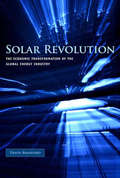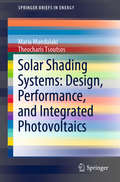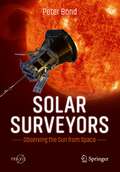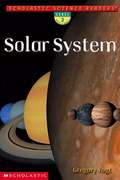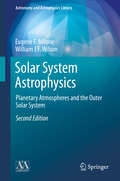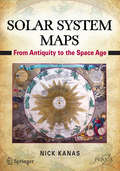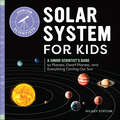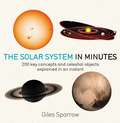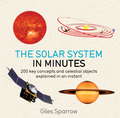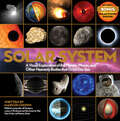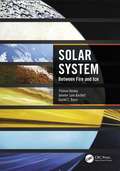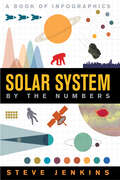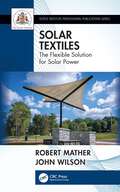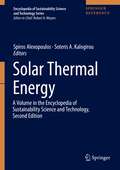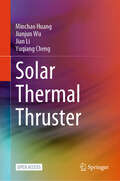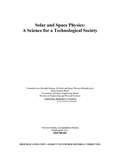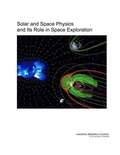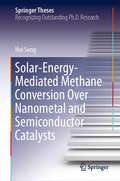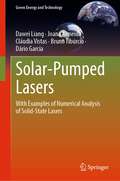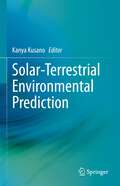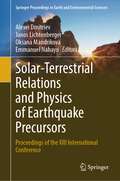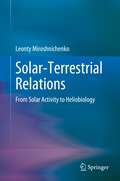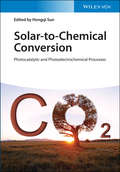- Table View
- List View
Solar Revolution: The Economic Transformation of the Global Energy Industry (The\mit Press Ser.)
by Travis BradfordAn innovative analysis that shows how the shift to solar energy—in particular, the use of photovoltaic cells—is both economically advantageous and inevitable, and will rival the information and communication technologies revolution in its transformative effects.In Solar Revolution, fund manager and former corporate buyout specialist Travis Bradford argues—on the basis of standard business and economic forecasting models—that over the next two decades solar energy will increasingly become the best and cheapest choice for most electricity and energy applications. Solar Revolution outlines the path by which the transition to solar technology and sustainable energy practices will occur.Developments in the photovoltaic (PV) industry over the last ten years have made direct electricity generation from PV cells a cost-effective and feasible energy solution, despite the common view that PV technology appeals only to a premium niche market. Bradford shows that PV electricity today has become the choice of hundreds of thousands of mainstream homeowners and businesses in many markets worldwide, including Japan, Germany, and the American Southwest. Solar energy will eventually be the cheapest source of energy in nearly all markets and locations because PV can bypass the aging and fragile electricity grid and deliver its power directly to the end user, fundamentally changing the underlying economics of energy. As the scale of PV production increases and costs continue to decline at historic rates, demand for PV electricity will outpace supply of systems for years to come. Ultimately, the shift from fossil fuels to solar energy will take place not because solar energy is better for the environment or energy security, or because of future government subsidies or as yet undeveloped technology. The solar revolution is already occurring through decisions made by self-interested energy users. The shift to solar energy is inevitable and will be as transformative as the last century's revolutions in information and communication technologies.
Solar Rotation (UNITEXT for Physics)
by Arnold Hanslmeier Roman BrajšaThe rotation of the Sun is a basic parameter which constrains the boundary conditions for the model of the MHD-dynamo mechanisms that generates solar activity. The Sun is a slowly rotating star with a convection zone below the surface which is the site of the solar dynamo. The solar rotation depends on the latitude, depth/height and time, i.e., the Sun rotates differentially. In the book several aspects of the solar rotation are covered. Only in the case of the Sun we can directly observe details in its atmosphere and so measure the rotation velocity using various tracers, which is one of the mostly used methods for rotation determination. So, the Sun is a prototype for studying other stars. Different techniques that enable to determine solar rotation (e.g., tracer method, spectroscopic method, helioseismology) are presented and their results are compared and interpreted. In the current literature there is no book exclusively about solar rotation published in the last several decades. The book is intended for astrophysicists, both professionals as well as students and people interested in science in general. The reader would strongly benefit from the comprehensive description of several topics related to the solar rotation. The authors are highly experienced in teaching astrophysics both to astrophysicists, solar physicists as well as to the public. Therefore, from the didactical point of view the book is written basically as a textbook, so the reader that is not deep within that field can gain an overview. Moreover, for those who want to get deeper into the topics, additional information is given, and recommendations for further literature as well as many citations to recent publications. The reader will get both (i) a general introduction into the topics (ii) overview of recent publications on the topics. Therefore, the book can serve as a textbook but will be also very useful for research and thesis writing, for example.
Solar Shading Systems: Design, Performance, and Integrated Photovoltaics (SpringerBriefs in Energy)
by Maria Mandalaki Theocharis TsoutsosThis is the first book to describe the development of and state of the art in solar shading devices in buildings, detailing all methods of evaluating shading systems according to thermal and visual comfort. The issue of energy balance in buildings is gaining importance as conventional energy sources dwindle and become more expensive. As such, environmental concerns should be considered in overall design decisions. The book discusses the role sun control “machines” play in controlling solar and thermal radiation. It examines their geometry, their position in relation to glazing and their operation (in the cases of movable systems) to control the heat and light entering a building, as well as how their material and color influence their performance. This book appeals to architects and designers who are interested in efficient energy facade design.
Solar Surveyors: Observing the Sun from Space (Springer Praxis Books)
by Peter BondThis is the story of humankind’s quest over centuries to learn the true nature of the most dominant object in our Solar System: the Sun.Award-winning science writer Peter Bond describes in detail how our ideas about the Sun have changed over the millennia, starting with the simple observations of classical astronomy and continuing through telescopic observations to the age of nuclear physics. He shows how we discovered the Sun’s basic characteristics – its distance, size, temperature and composition – and then describes how, with evermore sophisticated instruments, we have learned about the Sun’s enormous energy output, its atmosphere and the explosive eruptions that blast clouds of magnetized gas and high-energy particles toward our world.Most of this book focuses on the Space Age, when suborbital rockets and satellites have probed every aspect of our nearby star. Each of these missions is described in detail, with summaries of their objectives, spacecraft designs, scientific payloads and results. The book also looks forward, describing forthcoming missions that will shed new light on remaining solar mysteries, notably the source of the energy that heats the outer corona to millions of degrees.Richly illustrated with mission photos, design diagrams, and infocharts, this book is a fascinating read for anybody interested in the Sun and our attempts to unravel its secrets.
Solar System
by Gregory VogtTake a journey through space! The Scholastic Science Readers series was created especially to bring exciting nonfiction to beginning readers. Ilustrated with full-color photographs. A simple explanation of the sun, moon, and the nine planets, with additional facts about asteroids and space exploration. Learn what the sun is made of, and how the sun's gravity makes the planets orbit around it. Find out how far each planet is from the sun, how many moons it has, and what it looks like up-close! Why study the solar system? Space exploration could explain the history of the universe or reveal whether there is other life out there!
Solar System Astrophysics
by Eugene F. Milone William J.F. WilsonThe second edition of Solar System Astrophysics: Background Science and the Inner Solar System provides new insights into the burgeoning field of planetary astronomy. As in the first edition, this volume begins with a rigorous treatment of coordinate frames, basic positional astronomy, and the celestial mechanics of two and restricted three body system problems. Perturbations are treated in the same way, with clear step-by-step derivations. Then the Earth's gravitational potential field and the Earth-Moon system are discussed, and the exposition turns to radiation properties with a chapter on the Sun. The exposition of the physical properties of the Moon and the terrestrial planets are greatly expanded, with much new information highlighted on the Moon, Mercury, Venus, and Mars. All of the material is presented within a framework of historical importance. This book and its sister volume, Solar System Astrophysics: Background Science and the Inner Solar system, are pedagogically well written, providing clearly illustrated explanations, for example, of such topics as the numerical integration of the Adams-Williamson equation, the equations of state in planetary interiors and atmospheres, Maxwell's equations as applied to planetary ionospheres and magnetospheres, and the physics and chemistry of the Habitable Zone in planetary systems. Together, the volumes form a comprehensive text for any university course that aims to deal with all aspects of solar and extra-solar planetary systems. They will appeal separately to the intellectually curious who would like to know how just how far our knowledge of the solar system has progressed in recent years.
Solar System Dynamics
by Carl D. Murray Stanley F. DermottThe force of gravity acting over eons has provided the solar system with an intricate dynamical structure, much of it revealed by recent space missions. This comprehensive introduction to the dynamical features of the solar system also provides all the mathematical tools and physical models needed for a complete understanding of the subject. Clearly written and well illustrated coverage shows how a basic knowledge of the two- and three-body problems and perturbation theory can be combined to understand features as diverse as the tidal heating of Jupiter's moon Io, the origin of the Kirkwood gaps in the asteroid belt, and the radial structure of Saturn's rings. Problems at the end of each chapter and a free Internet Mathematica® software package help students to fully develop their understanding of the subject. This volume provides an authoritative textbook for advanced undergraduate and graduate courses on planetary dynamics and celestial mechanics. It also equips students with the mathematical tools to tackle broader courses on dynamics, dynamical systems, applications of chaos theory and nonlinear dynamics. Written by two leading figures in planetary dynamics, it is a benchmark publication in the field and destined to become a classic.
Solar System Maps
by Nick KanasIn recent years, there has been increased interest in our Solar System. This has been prompted by the launching of giant orbiting telescopes and space probes, the discovery of new planetary moons and heavenly bodies that orbit the Sun, and the demotion of Pluto as a planet. In one generation, our place in the heavens has been challenged, but this is not unusual. Throughout history, there have been a number of such world views. Initially, Earth was seen as the center of the universe and surrounded by orbiting planets and stars. Then the Sun became the center of the cosmos. Finally, there was no center, just a vast array of galaxies with individual stars, some with their own retinue of planets. This allowed our Solar System to be differentiated from deep-sky objects, but it didn't lose its mystery as more and more remarkable bodies were discovered within its boundaries. This book tells the exciting story of how we have conceptualized and mapped our Solar System from antiquity to modern times. In addition to the complete text, this story is made more vivid by: * 162 Solar System and planetary maps, diagrams, and images (over a third in color); * direct quotes and figures from antiquarian, contemporary, and Space Age documents and photographs that allow the reader to track how humans have viewed the Solar System from original sources; * nine tables that compare the various world views, relative planetary positions, and components of the Solar System with each other. Broad in scope and rich in imagery, this book will draw the reader into the story of our Solar System and how it has been mapped since the beginning of recorded time.
Solar System for Kids: A Junior Scientist's Guide to Planets, Dwarf Planets, and Everything Circling Our Sun (Junior Scientists)
by Hilary StatumTake kids ages 6 to 8 on a guided tour of the galaxy—blast off with the Junior Scientists seriesSpace is limitless—just like your imagination! Get ready to take an amazing journey to the stars. Solar System for Kids is filled with fascinating facts, photographs, and illustrations that'll excite your mind and charge your curiosity. Of all the solar system books for kids 6-8, this one teaches you about the birth of the universe and how scientists believe galaxies, stars, and planets came into being. Explore the Sun, planets, dwarf planets, moons, and the asteroid belt in one of the most engaging solar system books for kids.This standout among solar system books for kids offers tips for spotting constellations, planets, comets, and more—from your backyard. From navigating the night sky to learning about objects billions of miles away, this book answers curious kids' big questions about the universe. Strap in, Junior Scientist. 3, 2, 1... blast off!This top choice among solar system books for kids includes:Universally easy—Explore the whole universe with in-depth and easy-to-follow information in one of the most comprehensive solar system books for kids.Deep space knowledge—From dark matter and black holes to eclipses and moon landings, this book explores every aspect curious kids want to know.Bonus material—Discover even more fun information by using the extensive glossary, sidebars, and in-book activities.If you've been searching for solar system books for kids, look no further—this one has you covered.
Solar System in Minutes
by Giles SparrowThe Solar System in Minutes explains the history and features of all the major celestial bodies, including the Sun, Mercury, Venus, Earth, Mars, Jupiter, Saturn, Uranus, Neptune, the planets' main moons, the asteroids, comets, dwarf planets, and the Kuiper belt, as well as the birth, evolution, and science of the solar system and the story--and future--of its exploration.With 200 of the very latest space images and explanatory diagrams that bring these concepts to life, Solar System in Minutes is the easiest way to understand our cosmic neighborhood.
Solar System in Minutes (IN MINUTES)
by Giles SparrowThis concise, illuminating guide takes us on a comprehensive tour of the solar system, from the Sun at its very heart - via the planets and their moons - to the icy objects at its periphery, some 150 billion kilometres away. The Solar System in Minutes explains the history and features of all the major celestial bodies, including the Sun, Mercury, Venus, Earth, Mars, Jupiter, Saturn, Uranus, Neptune, the planets' main moons, the asteroids, comets, dwarf planets and the Kuiper belt; as well as the birth, evolution and science of the solar system and the story - and future - of its exploration. With 200 of the very latest space photographs and explanatory diagrams, here is the easiest way to understand our cosmic neighbourhood.
Solar System: A Visual Exploration of All the Planets, Moons, and Other Heavenly Bodies That Orbit Our Sun—Updated Edition (Solar System)
by Marcus ChownNow updated with the journeys of the 2012 Mars rover Curiosity and the 2020 Mars rover Perseverance, Solar System undertakes an astonishing visual journey through time and space through fascinating text, original graphics, and stunning photographs.Never before have the wonders of our solar system been so immediately accessible to readers of all ages. Award‑winning writer and broadcaster Marcus Chown combines science and history to visually and narratively explore our neighboring planets, dwarf planets, moons, asteroids, comets and more, as well as the historical figures who aided in their discoveries. From the explosive surface of the sun to the new missions on Mars; from the gargantuan rings of Saturn to the volcanoes of Io; from the latest images of Pluto from NASA's New Horizons probe, to a simulation of what the Oort Cloud might look like, Solar System offers a window seat from which to view the beauty and magnificence of space.
Solar System: Between Fire and Ice
by Thomas Hockey Jennifer Lynn Bartlett Daniel C. BoiceCombining the latest astronomical results with a historical perspective, Solar System: Between Fire and Ice takes you on a fabulous tour of our intriguing Solar System. Not content with a conventional discourse restricted to the major and minor bodies, astronomers Hockey, Bartlett, and Boice venture beyond the limits of our system to look at exoplanets and to consider future trends in space exploration and tourism. They discuss not only what scientists know about planets, asteroids, and comets but how the discoveries were made. With extensive teaching experience, their accessible prose clearly explains essential physical concepts. Lavishly illustrated as well as carefully researched, Solar System: Between Fire and Ice delights the eyes as well as feeding the mind. Detailed appendices provide additional technical data and resources for your own on-line voyage of discovery. Whether you are an educated layperson, student, teacher, amateur astronomer, or merely curious, you will come away having learned the most up-to-date knowledge and enjoyed the process. The authors bring a unique perspective to this subject, combining their years of experience in research, teaching, and history of planetary science. Prof. Thomas Hockey is a professor of astronomy, specializing in planetary science and the history of science. Dr. Jennifer Bartlett is an astronomer with a forte in dynamical motions of asteroids with liberal arts teaching experience. Dr. Daniel Boice is an active research astronomer in planetary science, especially comets, with considerable teaching experience. "In the 1980s and 90s the Viking and Voyager missions provided droves of exciting information, generating a new level of public interest. Textbooks were rewritten and scientists worked to understand the data during mission poor period that followed. In recent times, however, we have entered a new era. There has been a multinational effort to expand our knowledge of the Solar System. Data from these missions has been freely shared and has again raised the level of public interest. Within this era of renewed interest, it is appropriate, as is done in this book, to provide the public with an effort to present an integrated view of our Solar System and questions that the discovery of extrasolar planets have raised with regard to the Solar System as a whole." Professor Reta Beebe, recipient of NASA’s Exceptional Public Service Medal "I understand this book to be aimed at a general audience, but I can also see its use as a text in astronomy classes, especially in a community school or situations where students typically resist reading the textbook. The writing is light and entertaining, and will engage students, yet it thoroughly covers all the basic concepts of a typical Astro 101 class." - Dr. Katy Garmany, winner of the American Astronomical Society’s Annie J. Cannon Award.
Solar System: By The Numbers (By the Numbers)
by Steve JenkinsBy the Numbers infographic readers, accessible nonfiction packed with full-color cut-paper illustrations from Caldecott honor–winning Steve Jenkins. Solar Systems focuses on ever-astonishing outer space.Through infographics and illustrations readers will learn about the unfathomably huge and fascinating topic of solar systems. Explore the galaxy that surrounds our planet through astounding numbers, facts, and figures. With Steve Jenkins&’s signature art style, his By the Numbers reader series explores the most fascinating fields of nature and natural science. These readers are fact-packed and run the gamut from dinosaurs to dwarf planets, detailing the astonishing phenomena that make our universe such an incredible place to live and learn. Each title uses engaging graphics and visual literacy to convey scientific facts and concepts, making them accessible for all kinds of new readers.
Solar Textiles: The Flexible Solution for Solar Power (Textile Institute Professional Publications)
by John Wilson Robert MatherMost photovoltaic (PV) installations utilise heavy conventional glass or polycarbonate panels, and even newly developed thin plastic or metal films for PV cell use may fracture during both construction and application. Textile fabrics, the most widespread flexible materials in everyday use, offer a solution to the need for lightweight, flexible solar PV generators. Solar Textiles: The Flexible Solution for Solar Power is about the incorporation and operation of solar cells on textile fabrics. The combination of textile manufacturing and solar PV cell technology opens up further avenues for both the textile and semiconductor industries. Thus, this book reflects the progressively increasing commercial interest in PV cell technology and the versatility that their integration in textiles provides. Discusses textiles as electrical substrates Explains the photovoltaic effect and associated parameters Offers special consideration of solar cells on textiles Compares fibres and fabrics and how to implement PV activity on a textile Describes manufacturing methods outside of semiconductor technology Includes applications open only to textiles This work is aimed at textile technologists, electronic engineers, solar technologists, civil engineers and designers in building fabrics and architecture.
Solar Thermal Energy (Encyclopedia of Sustainability Science and Technology Series)
by Spiros Alexopoulos Soteris A. KalogirouThis volume of the Encyclopedia of Sustainability Science and Technology, Second Edition, describes technologies that actively convert solar radiation into useful heat in a temperature range from just above ambient up to more than 1,000°C. Applications cover a broad range of energy services such as space heating, cooking, domestic hot water supply, electrical power generation, and high temperature thermochemical processes. The major developments that have led to currently available technologies for solar thermal energy applications were initiated mainly after the first oil shock in 1973. Solar thermal energy is widely used already for heating purposes (water, space) in the “low” temperature range up to about 100°C employing mainly nonconcentrating collectors, whereas higher temperatures can be achieved with more sophisticated solar collector technologies. Temperatures over 200°C typically require concentrating solar radiation using mirror systems. Several different technologies are described in detail in this volume, including solar collector systems in the lower temperature range, the direct use of solar radiation for food processing, namely cooking and drying, the production of electricity through conversion of solar radiation first to heat, driving a mechanical conversion system coupled to an electric generator, the use of solar radiation to drive chemical processes, and many more.
Solar Thermal Thruster
by Jian Li Jianjun Wu Minchao Huang Yuqiang ChengThis open access book focuses on the field of aerospace propulsion theory and engineering. The book takes the solar thermal thruster as the research object, has carried on the solar thermal thruster working process theoretical analysis, the numerical simulation and the experimental verification, and has revealed the solar thermal thruster internal working mechanism, and a design optimization method for high performance solar thermal thruster is presented. The research contents reflect the latest research results of performance analysis of solar thermal thrusters. This book is used as a textbook or reference book for teachers, students and scientists in the fields of aerospace, aeronautics, engineering thermal physics and power.
Solar and Space Physics
by National Research Council Space Studies Board Division on Engineering and Physical Sciences Committee on a Decadal Strategy for Solar and Space Physics Aeronautics and Space Engineering BoardFrom the interior of the Sun, to the upper atmosphere and near-space environment of Earth, and outward to a region far beyond Pluto where the Sun's influence wanes, advances during the past decade in space physics and solar physics--the disciplines NASA refers to as heliophysics--have yielded spectacular insights into the phenomena that affect our home in space. Solar and Space Physics, from the National Research Council's (NRC's) Committee for a Decadal Strategy in Solar and Space Physics, is the second NRC decadal survey in heliophysics. Building on the research accomplishments realized during the past decade, the report presents a program of basic and applied research for the period 2013-2022 that will improve scientific understanding of the mechanisms that drive the Sun's activity and the fundamental physical processes underlying near-Earth plasma dynamics, determine the physical interactions of Earth's atmospheric layers in the context of the connected Sun-Earth system, and enhance greatly the capability to provide realistic and specific forecasts of Earth's space environment that will better serve the needs of society. Although the recommended program is directed primarily at NASA and the National Science Foundation for action, the report also recommends actions by other federal agencies, especially the parts of the National Oceanic and Atmospheric Administration charged with the day-to-day (operational) forecast of space weather. In addition to the recommendations included in this summary, related recommendations are presented in this report.
Solar and Space Physics and Its Role in Space Exploration
by Committee on the Assessment of the Role of Solar Space Physics in NASA's Space Exploration InitiativeIn February 2004, the President announced a new goal for NASA; to use humans and robots together to explore the Moon, Mars, and beyond. In response to this initiative, NASA has adopted new exploration goals that depend, in part, on solar physics research. These actions raised questions about how the research agenda recommended by the NRC in its 2002 report, The Sun to the Earth and Beyond, which did not reflect the new exploration goals, would be affected. As a result, NASA requested the NRC to review the role solar and space physics should play in support of the new goals. This report presents the results of that review. It considers solar and space physics both as aspects of scientific exploration and in support of enabling future exploration of the solar system. The report provides a series of recommendations about NASA's Sun-Earth Connections program to enable it to meet both of those goals.
Solar-Energy-Mediated Methane Conversion Over Nanometal and Semiconductor Catalysts (Springer Theses)
by Hui SongThis book demonstrates that solar energy, the most abundant and clean renewable energy, can be utilized to drive methane activation and conversion under mild conditions. The book reports that coupling solar energy and thermal energy can significantly enhance methane conversion at mild temperatures using plasmonic nanometal-based catalysts, with a substantial decrease in apparent activation energy of methane conversion. Furthermore, this book, for the first time, reports the direct photocatalytic methane oxidation into liquid oxygenates (methanol and formaldehyde) with only molecular oxygen in pure water at room temperature with high yield and selectivity over nanometals and semiconductors (zinc oxide and titanium dioxide). These findings are a big stride toward methane conversion and inspire researchers to develop strategies for efficient and selective conversion of methane to high-value-added chemicals under mild conditions.
Solar-Pumped Lasers: With Examples of Numerical Analysis of Solid-State Lasers (Green Energy and Technology)
by Joana Almeida Dawei Liang Cláudia Vistas Bruno Tibúrcio Dário GarciaThis textbook is a comprehensive review of many different areas in solar-pumped lasers design and characterization. It enables readers to develop their skills in general solid-state laser design and solar collector design and provides numerous solved exercises at the end of each chapter to further this development. This book begins by introducing the brief history of solar-pumped laser and its potential applications. It explains the basic theories of imaging and non-imaging primary, secondary, and tertiary solar concentrators. It discusses solar-pumped solid-state laser theory and solar-to-laser power conversion efficiencies. There are chapters dedicated to ZEMAX and LASCAD numerical simulation tools, to help develop readers’ skills in innovative solid-state laser design. This book is one of the first books to relate concentrated solar energy technologies to solid-state laser technologies and is therefore of interest to students, academics, engineers, and laser and optical system designers.
Solar-Terrestrial Environmental Prediction
by Kanya KusanoPowerful solar explosions, such as flares and coronal mass ejections, greatly disturb the electromagnetic environment around the Earth and the atmosphere. They may even impact various social systems—communications, positioning, electric power supply, aviation and activities in space. Such variations in the space environment, which can influence human activities, are called “space weather.” The space weather disaster caused by a solar explosion is a potential risk in modern society. To reduce and mitigate space weather impacts, it is essential to understand the structure and dynamics of the solar–terrestrial environment and to predict the variations. This book comprehensively describes space weather, from the basics of related sciences to the possible social impacts. It was compiled based on a national research project on solar–terrestrial environment prediction conducted in Japan recently. It consists of four parts: the linkage between space weather and society; the magnetosphere of the Earth and space weather prediction; solar storms and space weather prediction; and long-term prediction of solar cycle activity and climate impacts. Each chapter covers the basics and applications of each area, which helps readers gain a broad understanding of the subject matter throughout the book. In addition, readers are able to select and read the topics they are most interested in. It is especially valuable for undergraduate and graduate students and young researchers studying space weather and related topics, and is further helpful for experts in various industries related to space weather disasters. The translation was done with the help of artificial intelligence (machine translation by the service DeepL.com). The present version has been revised technically and linguistically by the authors in collaboration with a professional translator.
Solar-Terrestrial Relations and Physics of Earthquake Precursors: Proceedings of the XIII International Conference (Springer Proceedings in Earth and Environmental Sciences)
by Alexei Dmitriev Janos Lichtenberger Oksana Mandrikova Emmanuel NahayoThis book contains the papers selected by the Scientific Committee and represented at the XIII International Conference "Solar-Terrestrial Relations and Physics of Earthquake Precursors", which was hold at the Institute of Cosmophysical Research and Radio Wave Propagation, Far Eastern Branch of the Russian Academy of Sciences, Kamchatka. The papers describe the investigation results in the fields of atmosphere, ionosphere and magnetosphere physics. Mechanisms of transformation of solar wind energy into the energy of magnetospheric-ionospheric processes, effects of the processes in the Earth core on the lower and upper atmosphere, seismo-electromagnetic, seismo-electric and seismo-acoustic effects at different frequency ranges in the Earth crust, atmosphere and ionosphere are under consideration. Modern methods for geophysical data collection, processing, transfer and exchange as well as organisation issues of seismic activity monitoring are presented.The Conference "Solar-Terrestrial Relations and Physics of Earthquake Precursors" has 25 years of history. Scientists from Russia, Japan, Hungary, China, India, USA and other countries participate in it. In a traditional way, the Conference includes three sections: atmosphere physics, geophysical fields and their interaction, physics of earthquake precursors.
Solar-Terrestrial Relations: From Solar Activity to Heliobiology
by Leonty MiroshnichenkoThis books presents a brief review of modern concepts of the Sun-Earth problem and proposed physical mechanisms of solar-terrestrial relations (STR). This field covers a wide range of fundamental and actual applied problems of paramount importance (Space Weather, radiation hazard in space, functioning of space-borne and ground-based technological systems, heliobiology etc.). It is also closely tied with some general gnosiological problems.The author provides state-of-the-art information about existing problems and discusses different channels for extraterrestrial influences at the up-to-date level: electromagnetic waves and fields, total solar irradiance, solar wind, energetic solar particles, galactic cosmic rays, cosmic dust, etc. Some of the well-known and suggested STR effects and corresponding physical mechanisms are illustrated by several examples. In particular, a number of different external “signals” in observed changes of terrestrial climate and weather are considered. Especially, an expected impact of geophysical disturbances on the accuracy of some precise physical measurements and experiments is analysed. Due attention is paid to the heliobiological aspects of STR. Particular emphasis is on the multifactor nature of magneto-biological effect (MBE), its non-stationary and non-linear behaviour. The author also discusses main features of different physical mechanisms (electromagnetic fields, ionising radiation, triggers, rhythmic and resonances in solar-terrestrial systems) and their applicability to the Sun-Earth problem. The most of them are still needed in more sophisticated theoretical development and experimental confirmation. The main goals of interdisciplinary studies in this field are to determine partial impacts of solar-geomagnetic variability on the terrestrial environments and estimate (separate) relative contributions of different factors into various STR phenomena. The book is based on lectures given on advanced undergraduate level and will also benefit newcomers (physicists and engineers) to the field.
Solar-to-Chemical Conversion: Photocatalytic and Photoelectrochemical Processes
by Hongqi SunThis comprehensive book systematically covers the fundamentals in solar energy conversion to chemicals, either fuels or chemical products. It includes natural photosynthesis with emphasis on artificial processes for solar energy conversion and utilization. The chemical processes of solar energy conversion via homogeneous and/or heterogeneous photocatalysis has been described with the mechanistic insights. It also consists of reaction systems toward a variety of applications, such as water splitting for hydrogen or oxygen evolution, photocatalytic CO2 reduction to fuels, and light driven N2 fixation, etc. This unique book offers the readers a broad view of solar energy utilization based on chemical processes and their perspectives for future sustainability.
